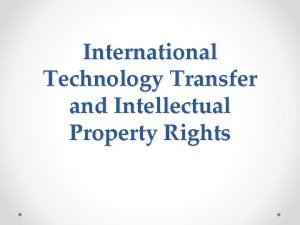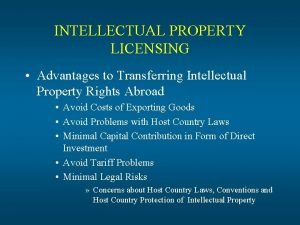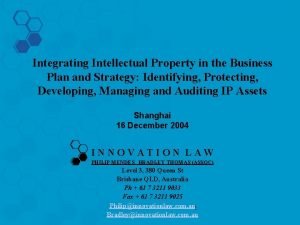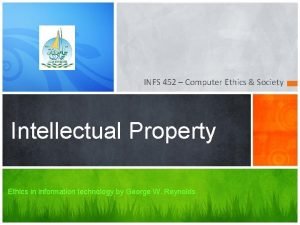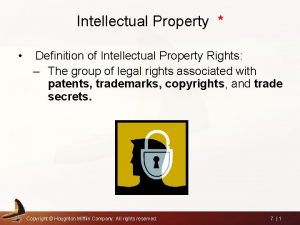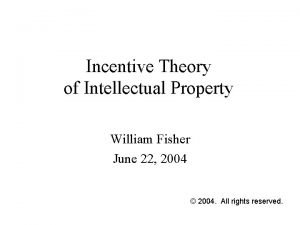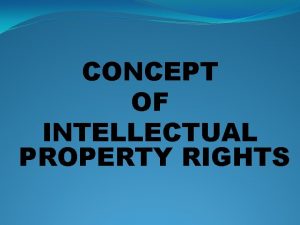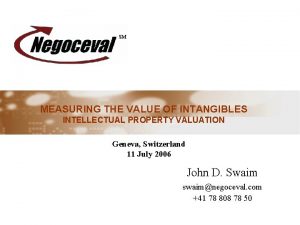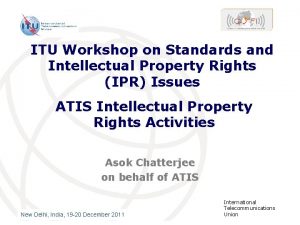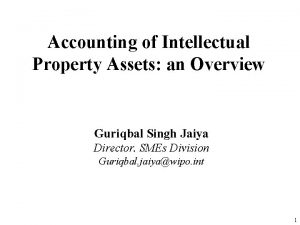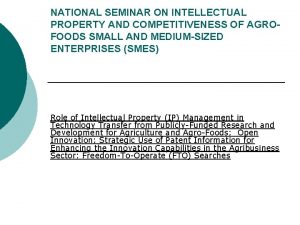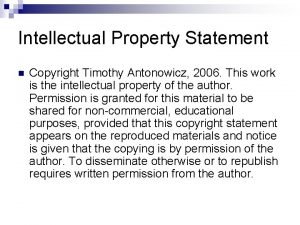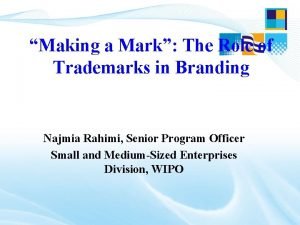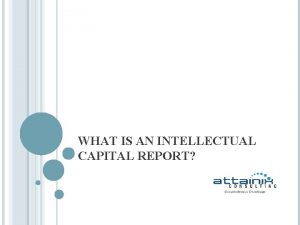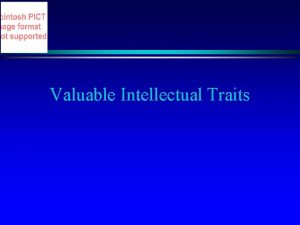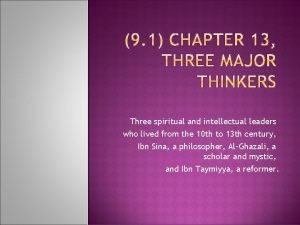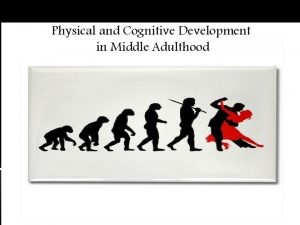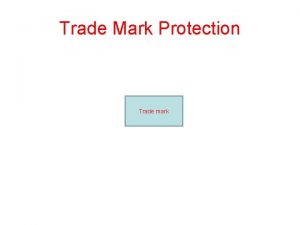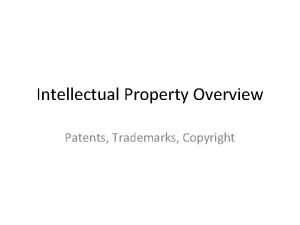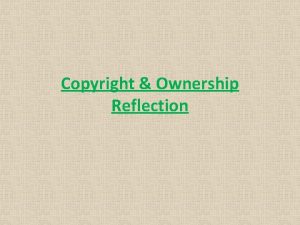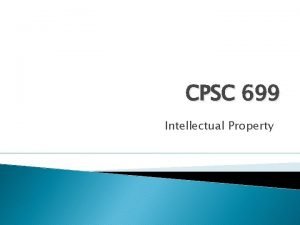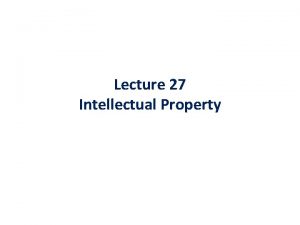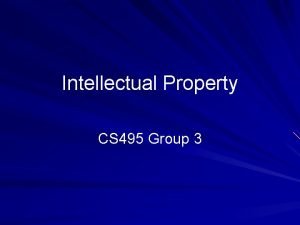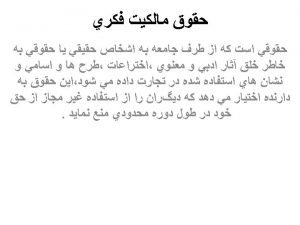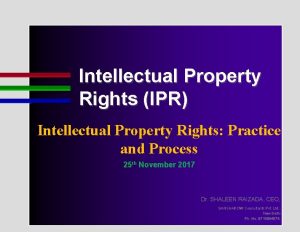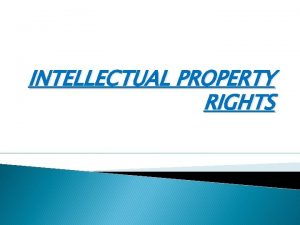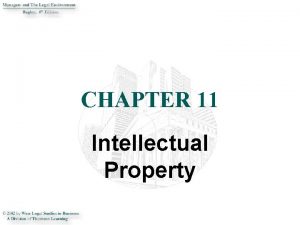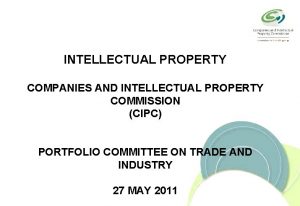Intellectual property Copyright Trade mark Intellectual property IP












































- Slides: 44

Intellectual property Copyright &Trade mark

Intellectual property (IP) ü What is it? ü World intellectual property organization (WIPO) ü It refers to the ‘products of the mind’ Inventions, literary and artistic works, any symbols, names, images and designs used in commerce’.

World Trade Organization (WTO) ü ‘Rights given to people over the creations of their minds.

characteristics ü Intellectual property in nature, does not have a material existence. ü patents and trade marks can not be discussed except if the form of property ü Is a Tangible form

ü Therefore the most basic product of mind. IDEAS-cannot be protected.

But… ü Once in existence (tangible form), intellectual property rights have much in common with real property: ü 1. Intellectual property rights can be assigned/bequeathed (pass on or leave it to someone else). ü 2. Trespassers will be held to account

patent ü A patent is a set of exclusive rights granted by a state to an inventor or his assignee for a fixed period of time in exchange for a disclosure of an invention.

Example:

Example:

Example: ü New “wonder drug” ü Coca-cola sign ü A best-selling novel ü A new wonder drug Each constitute the physical embodiment of an intellectual property right.

Example: ü A registered trademark- coca-cola sign ü A copyright- a novel ü A patent- wonder drug

Think about it… ü Example: ü X manufactures; sells crisps under the registered mark ‘Mc Tatties’. ü Y starts to sell crisps under the mark ‘Mc Tatties’. ü Question: what has Y done?

Think about it… ü Y then sells crackers under the mark ‘Mc. Taggies’. ü X bring infringement proceedings against Y.

Thinks about it… ü Now, it is up to the court to decide whether the rights in the mark ‘Mc. Tatties’ accorded to X by registration, extend to his preventing Y from using a different mark on different goods!

Court’s decision ü The court will take into account a range of factors such as: ü Distinctiveness of X’s mark ü X’s reputation ü How the goods are sold (which may change over time)

Judgment ü In the end, the court will judge and it is this judgment that will mark out the boundaries of X’s rights in the mark ‘Mc. Tatties’, rather than just based on its presence as a trade mark register.

History of trademark ü 1565 1 st patent granted ü 1875 trade marks act: existence of registered trade marks. ü 1988 design right introduction ü LATE 18 C- a legal intellectual property law (patents, copyright, trade marks, industrial design rights) emerged in UK. ü Reason: IP is viewed as important economic assets $$$ (not anymore as rewards for mental labour)

ü 10 Break time

trademark ü The trade mark act 1994: ‘any sign capable of being represented graphically which is capable of distinguishing the goods or services of one undertaking from those of others’.

How it functions ü Trademarks functions to protect its function as an indicator or symbol of the products identity: It shows us the Origin of the goods or services.

example ü The registered trademark ‘X’ on soft drink should reliably tell the consumer that all drinks marked ‘X’ originate from a single proprietor- not from any other enterprise.

Changes in recent years… ü globalization 1. The ownership of many well known brands is being concentrated in a small number of companies- many which operates internationally.

ü As a result, the trademark ‘X’ on soft drink may not mean it is produced by ‘X’ soft drink limited, but by its brand owner- a large multinational, which may also produce a number of competing brands as well as their ‘own brand’ product.

2. The role of the trade mark as a guarantor of quality is less crucial to a wide range of goods and services. • Early trade mark enables consumer to choose between product of certain quality over those which have more dubious attributes

As a result: ü How ever nowadays, consumers can expert a certain minimum quality for a wide range of goods and services, whatever marks attaches to them.

As a result. . ü The competition between goods and services has come to depend not on their differing quality but in the attractiveness of the trade marks they carry.

Example: nike, adidas

Looking at the definition again: ü What does it mean by: ‘any sign capable of being represented graphically which is capable of distinguishing the goods or services of one undertaking from those of others’.

The sign is the subject matter of a registered trade mark. ü For example: NIKE of the ‘swoosh’

What does it mean? ü Any sign;

Any sign: ü A trade mark may consist of: ü Word(including personal names) ü Designs ü Letters ü Numerals ü The shape of goods or their packaging (‘cocacola’ bottles/ ‘Toblerone’ triangular chocolate) ü Slogans ü Radio jingles ü Sensory marks such as colours, smells, sounds, and gestures

üCapable of being represented graphically

Capable of being represent graphically ü Mark must be capable of graphic representation, so that the trade mark registry (TMR) can easily record and search for them, and so that they can be advertised in 2 d form.

ü However smells, colour and shapes may be more difficult to register. ü Ex: registering a trade mark which consist of ‘a chewy sweet on a stick’.

ü Registration rejected because this does not comply with acceptable forms of graphic representation: Because it does not define what is distinctive about the mark with precision ü Since it is not possible to understand the mark precisely without references to the sample of the goods, the mark was not capable of being represent graphically.

Registration refused: another example ü Application to register a ‘smell’ (balsamically fruit with slight hint of cinnamon), its structural formula and an ‘odour sample’ in a container. ü The registration was refused. Why?

ü Yes- therefore what would be an acceptable graphic representation if not able to represent itself visually?

Why? 1. The proposed mark could not be represented graphically. Does ‘capable of graphic representation’ means only visible form or also include meaning sign: Odours/ sounds- not visible but can be reproduced?

ü As long as it can be graphically represented, then it can be registered- through use of images, lines. Characters. Chemical formula or description is not sufficiently clear or precise nor stable or durable

ü Colour- can be graphically represented if its representation meets the standards of an internationally recognized identification code such as the pantone colour standards

Capable of distinguishing the goods or services of one undertaking from those of others ü All signs are deemed capable to distinguish the products they represent but whether it’s successfully registered depends on its capability to do so in practice.

example ü Two soap boxes: ü One in red with white word ‘soap’ ü The other in green with black word ‘soap’.

Example: ü This of course distinguish the 2 soaps but to satisfy the difference, the designs of these two boxes must be differentiated. ü It is also up to the applicant to persuade the TMR or court that his sign can function as a trade mark.

 Trade related aspects of intellectual property rights
Trade related aspects of intellectual property rights Intellectual property rights in professional practices
Intellectual property rights in professional practices Importance of intellectual property
Importance of intellectual property Intellectual property management definition
Intellectual property management definition Advantages of intellectual property
Advantages of intellectual property Intellectual property business plan example
Intellectual property business plan example Property
Property Right to intellectual property of teachers
Right to intellectual property of teachers Definition of ipr
Definition of ipr Incentive theory
Incentive theory Concept of intellectual property
Concept of intellectual property Intellectual property valuing
Intellectual property valuing Intellectual property rights
Intellectual property rights Intellectual property rights
Intellectual property rights Characteristics of intellectual property
Characteristics of intellectual property Discuss intellectual property frankly
Discuss intellectual property frankly Sfas 142
Sfas 142 Intellectual property
Intellectual property Intellectual property statement
Intellectual property statement Intellectual property business plan example
Intellectual property business plan example Evalueserve ip
Evalueserve ip Discuss intellectual property frankly
Discuss intellectual property frankly At&t ecommerce
At&t ecommerce Trade diversion and trade creation
Trade diversion and trade creation Trade diversion and trade creation
Trade diversion and trade creation Trade diversion and trade creation
Trade diversion and trade creation The trade in the trade-to-gdp ratio
The trade in the trade-to-gdp ratio Fair trade not free trade
Fair trade not free trade Trade diversion and trade creation
Trade diversion and trade creation Tramp chartering
Tramp chartering Triangular trade video
Triangular trade video Types of trade mark
Types of trade mark Commutative and associative properties
Commutative and associative properties Obstructed and unobstructed heritage
Obstructed and unobstructed heritage Chemical property of water
Chemical property of water Intellectual capital examples
Intellectual capital examples Intellectual giftedness
Intellectual giftedness What are the intellectual traits
What are the intellectual traits The intellectual and spiritual leaders
The intellectual and spiritual leaders Rias iq test
Rias iq test Intellectual development in middle adulthood
Intellectual development in middle adulthood Borderline intellectual functioning
Borderline intellectual functioning Ascending levels of intellectual demand
Ascending levels of intellectual demand Late adulthood mental development
Late adulthood mental development Integrity
Integrity


